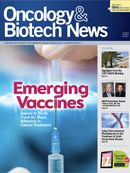Publication
Article
Oncology & Biotech News
Population Stratification and Cancer Risk Assessment: An Interview With Jill Barnholtz-Sloan, PhD
Author(s):
Population stratification refers to differences in allele frequencies between cases and controls, resulting from systematic differences in ancestry, as opposed to associations between genes and disease.

Jill Barnholtz-Sloan, PhD
Population stratification refers to differences in allele frequencies between cases and controls, resulting from systematic differences in ancestry, as opposed to associations between genes and disease. As a scientific discipline, the study and application of the principles of population stratification are poised to assume a position of increased relevance in medicine, owing to recent advances in the field of genetics. At the AACR meeting, Jill Barnholtz-Sloan, PhD, an epidemiologist and biostatistician at Case Western Reserve University in Cleveland, Ohio, chaired a session on the role of population stratification and genetic ancestry in cancer risk assessment. Afterward, she discussed recent developments in the field.
OBTN: Is population stratification a new area of genetics? If not, why is it attracting interest at this point in time?
Dr Barnholtz-Sloan: The idea of population stratification is not new. It’s a theoretical population genetics effect that we have known about for a long time. It is a potential bias that occurs in studies when you have individuals of multiple different ancestral groups, which we, of course, are in the United States. That can lead to bias in risk estimates. It can cause both false positives and false negatives. As with any other confounder, you need to be aware of this potential for bias if you have an admix population that you are interested in studying.
I think one reason that population stratification has come to the forefront now is that it has become a standard in genome-wide association studies, or GWAS, where you use some of these population stratification testing procedures that allow you to identify and exclude individuals who might be outliers, even before you perform the GWAS or analysis. Epidemiologists have been using population stratification, on and off, for the last few decades or so. I think where it will really become important now is the validation of GWAS studies that have been done primarily in European and European-American populations up to this point. People are now looking to see whether they have applicable Hispanic American datasets, Asian American datasets, [and] African American datasets to see whether they replicate the findings that have been obtained in European Americans and Europeans. African Americans, Hispanic Americans, and Asian Americans are more recently admixed. They have continuous gene flow and because of that, the potential for population stratification effects is greater so it becomes more necessary to use these types of approaches.
Is population stratification applicable to all types of cancer?
Yes, absolutely. It has nothing to do with the type of cancer. It has to do with what you know about the immigration and migration patterns and the ancestral background of your study population. That helps you figure out which one of the techniques you want to use [and] which type of ancestry-informative markers you want to genotype to get your ancestry estimates.
What types of datasets are used in this type of research?
Until recently, we relied on HapMap data, which is [an] international haplotype mapping project. They have available data from an African ancestral population, Japanese and Chinese ancestral populations, and European ancestral populations. The Thousand Genomes Project, which is just now starting to come online and people are starting to use, has expanded the idea of the HAPMAP to many more populations in Africa, many more populations in Europe, many more populations across East Asia, and many other worldwide populations, to use as ancestral groups. Things will change as those data are mined.
Where does this research lead? How does it benefit clinical research or clinical practice?
One of the big debates in the literature now is: how far has GWAS gotten us? How do we use what we found thru GWAS studies to help inform risk prediction in the clinic for patients, to possibly screen for risk and possibly identify high-risk individuals? Right now, many of the regions in the genome that have been found to be significant via GWAS are so large that you can’t possibly figure out which one can be the functional variant. Again, that is because the vast majority of GWAS studies involved only Europeans and European Americans. Using some of these more recently admixed groups— African Americans, Hispanic Americans, Asian Americans—allows you to narrow down those regions. You look at the same regions across many different populations. You look at variants that are conserved across populations and then you know that it must be a really important variant. We are better able to pare down some of the information into a more workable set so that, hopefully, we can develop risk tools for the clinic.
What does all of this mean for practicing oncologists?
[In March], Nature Genetics published a paper about a study looking at ancestry, acute lymphoid leukemia, and prediction of response to treatment (Nat Genet. 2011;43:237-241). In the study, individual ancestry was estimated and used to stratify the data into a patient population with a higher proportion of European American ancestry versus a population that did not. The results showed that you can actually use ancestry to define response-to-treatment groups. This is the first time that population stratification and ancestry estimation [have] been used this way for a pharmacogenetic study and published in a high-profile journal.
There is increasing awareness of the lack of minority representation in clinical trials in United States and increasing emphasis at the National Institutes of Health to increase the number of minority patients enrolled in clinical trials. I think we are approaching a time of realization that we need to think about looking at ancestry, not just for risk prediction, but also for response prediction.
Did any new or surprising information come from the session on ancestry and population stratification that you moderated at the AACR meeting?
It was not a regular education session but more of a methods session. AACR asked me and the other speakers to provide a how-to session. For example, if I am conducting a study and I decide that I need to test for population stratification or adjust for that potential effect, how do I do it? How do I pick the markers? How do I pick the statistical method that I am going to use? How do I interpret the results? New methods are being developed all the time.
The other speakers on the program have been in population stratification and ancestry work much longer than I have, but I think I can speak for all of us when I say we’re thrilled to see the recent application of population stratification and ancestry in a pharmacogenetic study and were able to use ancestry to define response-totherapy groups.









